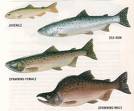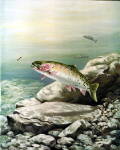

Fish
Rainbow Trout:
Devils Lake is stocked annually with hatchery raised rainbow trout.
Coho Salmon: An amazing and unique migration from salt water to fresh
water takes coho salmon from the Pacific Ocean, up the D River and Devils
Lake
tributaries to spawn. Possession of coho salmon from the lake is prohibited.
Grass
Carp: Devils Lake was stocked with grass carp by the Devils Lake Water
Improvement District as a method of controlling vegetation. Possession of Chinese
Grass
Carp (White
Amur) is
prohibited. Click
here for Grass Carp information.
Other
Fish: See below.
Devils Lake and its tributary Rock Creek provide habitat
for coho salmon.
Hatchery
raised Rainbow Trout are stocked annually by the Oregon Department
of Fish and
Wildlife (as many as 6,500 "planted" at a time). The
adipose fin is removed in the hatchery raised rainbow trout. Be careful not
to confuse the two fish.
• Devils Lake is managed to provide protection for wild coho
salmon.
• Only finclipped hatchery trout may be kept. Trout missing
the adipose fin may be kept. The adipose fin is the small fin on top
next to the tail.
• Non-finclipped wild trout and salmon must be released
unharmed.
Consult your current sport fishing regulation book. Look for
information signs around the lake about fish that can legally be kept.
 |
 |
|
| Coho Salmon | Rainbow Trout |
Coho Salmon
Devils Lake and Rock Creek have a very important, small, wild coho salmon population
listed as a threatened species. The state of Oregon is making a major
effort
to recover that species. The lake and creek have about 100 to 200 adult coho
spawners each winter. Juveniles in Rock Creek in the summer number about
10,000,
and the number in the lake is unknown. A smolt trap is placed at the
mouth of the D River at certain times of the year to study their migration.
Uniquely this population spawns from Christmas to the end of January, the latest
on the central and northern Oregon coast. Rock Creek has the highest coho density
on the north coast, higher than 100 surveys that include Siletz, Nestucca, Tillamook,
and Nehalem. Coho spawn in December or primarily January, juveniles emerge out
of the ground about April, stay in the fresh water lake about one full year,
then about the following April, May, or June go to the ocean. Some coho may
stay in Devils Lake longer than a year.
The Rock Creek dam project to allow easier fish passage was completed in September 2006, and involved the Salmon Drift Creek Watershed Council, the City of Lincoln City, the Preservation Association of Devils Lake, the Devils Lake Water Improvement District, the Oregon Watershed Enhancement Board, the Oregon Department of Fish and Wildlife and the U.S. Fish and Wildlife Service. Agency staff and volunteers worked on all aspects of the dam modification project.
"The Migration Game" Salmon
are great athletes Salmon
are quick change artists Salmon
are important |
An
interesting website about Wild Alaska Salmon - www.salmonpage.com
The
Oregon Plan for Salmon and Watersheds
The Oregon Plan for Salmon and Watersheds
represents an unprecedented undertaking on the part of the State of Oregon
to restore our state's salmon and trout resources. Their goal is to restore
populations and fisheries to productive and sustainable levels that will provide
substantial
environmental, cultural, and economic benefits. Visit www.oregon-plan.org/
Misc.
Native
fish: Other native fish using Devils Lake include steelhead, and cutthroat
trout.
1/07 -
Rare Pink Salmon Found in Rock Creek, Lake Ecology plays role:
A species of salmon not known to spawn in Oregon streams was found in Rock
Creek, a tributary of Devils Lake. A Pink Salmon also known as a
humpback was found on November 30th along the shores of the lower reach of
Rock Creek by
bio-surveyor Kip Wood. Wood and fellow biosurveyor Mark Stone work for
the Lincoln Soil & Water Conservation District. They regularly survey Rock
Creek along with numerous other creeks in the Mid-Coast Watershed.
 Wood said that the Pinks are rarely seen in streams this far south, and
that their general range reaches only as far as the Puget Sound. Adults
are seen off the coast of Oregon, but only a stray would find its way
into one of the coastal streams. Dr. Wayne Hoffman, Coordinator for the
Mid Coast Watershed Council added that these fish like systems that lack
an estuarine interface, meaning the fish are attracted directly to freshwater
outputs into the sea, not tidally affected waters like the Siletz or Salmon
Rivers. The D River, Devils Lake, and eventually Rock Creek provide just
such a system favored by the fish. Water flowing out of the lake is almost
always pure freshwater, which mimics the signal picked up on by the Pinks
in their native spawning grounds.
Wood said that the Pinks are rarely seen in streams this far south, and
that their general range reaches only as far as the Puget Sound. Adults
are seen off the coast of Oregon, but only a stray would find its way
into one of the coastal streams. Dr. Wayne Hoffman, Coordinator for the
Mid Coast Watershed Council added that these fish like systems that lack
an estuarine interface, meaning the fish are attracted directly to freshwater
outputs into the sea, not tidally affected waters like the Siletz or Salmon
Rivers. The D River, Devils Lake, and eventually Rock Creek provide just
such a system favored by the fish. Water flowing out of the lake is almost
always pure freshwater, which mimics the signal picked up on by the Pinks
in their native spawning grounds.
The lake ecology also plays a role in the native Coho's success this year. Region
wide Coho fish counts have been down said Wood, but not true for Rock Creek. Fish
counts in all reaches and tributaries of Rock Creek for December totaled 253
Coho. Wood cautioned that as they survey the streams multiple times during
the month, some of those fish might be counted more than once. However,
compared to the Yaquina basin where three streams produced only 32 Coho and
the South Fork of the Yachats which produced only 6 in two of its reaches,
the Rock Creek returns are significant. The reasoning Wood believes is
that Devils Lake provides exceptional rearing habitat for smolts. The
lake ecology allows the fish the opportunity to grow and mature over fish flowing
out of straight flush riverine systems like the Siletz. Salmon hitting
the Pacific from a lake system might be twice the size of their riverine counterparts,
providing a competitive advantage, an advantage that can show paybacks in years
like 2006-2007. Wood continued to say that the Coho in Rock Creek were
often 2 to 4 times the size of other Coho seen regionally. Fifteen pound
lunkers were spotted as compared to the 4 to 7 pounders seen generally elsewhere. The
Lincoln Soil & Water Conservation District meets at 7 pm every second Thursday
of the month in their offices at 23 North Coast Highway in Newport.
Pacific lamprey: Long, snake-like fish with suckers at their mouth,
the lamprey migrate into freshwater from the ocean, and they move from freshwater
to the ocean. They are very cool.
History
and Other Fish: Years ago there were black crappie, large mouth bass,
bluegill, and yellow perch. Since the introduction of the grass carp there
has been a significant
decline
of these species. Many of these fish need vegetation in the lake to hide from
predators. In the past, Christmas trees have been placed in the lake to
provide
cover for small fish, especially bass. Permits are no longer issued for this
activity. For information about grass carp refer to Restoration.
Devils Lake Fishing Tournament: Devils Lake is the site of an annual
fishing tournament on Father's Day weekend. Check with the Visitor and Convention
Bureau
for
information. In 2006, an Independence, Oregon man won $275 for catching a
large mouth bass - 18.5 inches, and 3.9 pounds.
Lead fishing tackle: In
Minnesota - The Minnesota Lakes Association (MLA) is partnering with the Minnesota
Office
of Environmental Assistance (OEA) and the Department
of Natural Resources (DNR) to offer lead tackle exchanges at various events
during the summer. This gives anglers a chance to trade in lead tackle for
non-lead tackle. Devils Lake anglers are encouraged not to use lead tackle.
www.moea.state.mn.us/reduce/sinkers.cfm
Take Me Fishing website - www.takemefishing.org/state/page/overview/state/or
 Photos:
Coho Salmon (Timothy Knepp, USFWS), Rainbow Trout (Duane Raver, USFWS), Finclipped
Trout
(ODFW), Pink Salmon (OSU), Cutthroat Trout (Robert W Hines, USFWS)
Photos:
Coho Salmon (Timothy Knepp, USFWS), Rainbow Trout (Duane Raver, USFWS), Finclipped
Trout
(ODFW), Pink Salmon (OSU), Cutthroat Trout (Robert W Hines, USFWS)
site map
algae & microscopic | biodiversity | birds | invasive
species | other animals | plants | home
Copyright ©
2003-2011 Preservation Association of Devils Lake (PADL).
All rights
reserved.
P.O. Box 36
Lincoln City, OR 97367
PADLsteward@wcn.net